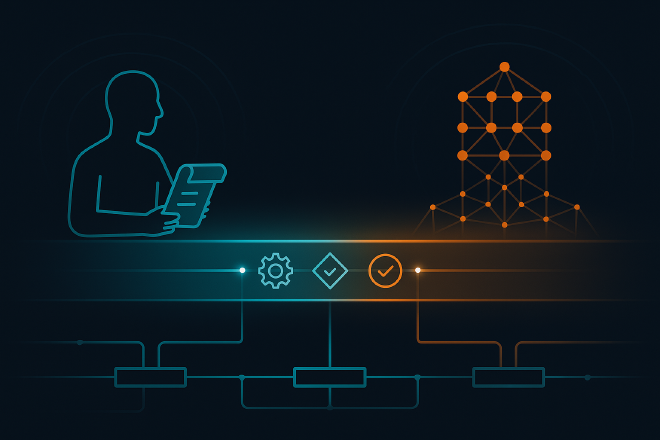Designing for Consistency: Where Logic Lives in Enterprise AI

The risk: logic drifts across agents and humans#
Autonomous agents are summarizing, routing, deciding, and acting. With that power comes a familiar problem: where should responsibility live? Every leap in abstraction scatters rules unless we deliberately centralize them. The result is inconsistency — outcomes that depend on who performed the action (human or agent), not on what the process required.
Before we go further, “logic” here means the decision structures, rules, and validations that determine how your enterprise behaves — not syntax or algorithms.
Where responsibility should live across agents, APIs, and humans#
Separation of concerns still matters. An agent’s job is not to replace your business processes; it’s to understand and navigate them. Validations, policies, and compliance checks belong in deterministic layers like APIs or process engines.
Coexistence demands consistency. Humans and agents act on the same systems. Your agent may add an extra validation; your human operators may rely on common‑sense heuristics. Those minor deltas compound into outcomes that vary by actor. Agents will expose where outcomes were consistent by habit, not by design — and that visibility is valuable.
Your API strategy is now part of your AI strategy. APIs are behavioral contracts. They define what “correct” means. Agents depend on them for both access and correctness. Encapsulate rules and validations in APIs; let agents choose which process to trigger and how to react to errors — not re‑implement the rules.
Beyond APIs: the human layer still matters. Not every step is codified, and that’s fine. Some decisions depend on judgment or tacit knowledge. Treat agents like very capable new hires: fast learners, but unaware of informal rules. Decide what gets codified, documented, or deliberately kept as human discretion. That boundary becomes the new frontier of process design.
Example: how small agent–human deltas create governance gaps#
Imagine a support flow where both humans and agents can initiate refunds. Humans follow a guideline (“confirm customer eligibility”); the agent adds a confidence‑threshold check before calling the refund API. Both paths call the same API, but one applies an extra filter. Over time, those small deltas become governance gaps.
Building an agent becomes a test by fire for your APIs and procedures. You’ll find validations that no longer make sense, or error messages no human ever saw because operators instinctively filled the gaps. When humans act, we rely on trust and experience. When agents act, we need explicit guidance.
Checklist to centralize logic and keep behavior consistent#
When defining responsibilities between agents, humans, and APIs, use these four principles:
Single source of validation
- Keep business validations in deterministic layers (APIs, process services).
- Let agents call them — don’t replicate them in agent logic.
Clear error semantics
- Teach agents to interpret and respond to API errors meaningfully.
- Treat errors as part of the dialogue, not exceptions to hide.
Role-based responsibility
- Agent: orchestration, reasoning, intent alignment.
- API: enforcement, validation, traceability.
- Human: oversight, escalation, contextual judgment.
Design for consistency, not symmetry
- It’s fine for agents and humans to have different capabilities — if differences are deliberate and documented.
- Every inconsistency should be a design choice, not an accident.
When to use deterministic validation over probabilistic AI#
As argued in If You Can’t Afford to Be Wrong, Think Twice, not every decision should be probabilistic. Some systems demand deterministic validation — to contain uncertainty, ensure compliance, or prevent brand exposure. Your agent can propose, but your APIs must still validate, constrain, and protect.
Executive takeaways#
- Agents should understand your processes, not become them.
- Minor inconsistencies between humans and agents can scale into governance drift.
- APIs are behavioral contracts; procedures are their human complement.
- Deterministic APIs and clear procedures are the backbone of consistent, compliant behavior.
- Consistency is not control — it’s risk governance for distributed intelligence.
- Building agents will stress‑test your APIs (and documentation) harder than any audit.
What to review next in your environment#
If your organization is experimenting with agents, start by reviewing where responsibility lives across systems. Ask:
- Are validations centralized?
- Are guidelines documented or implicit?
- Are agents invoking processes — or reinventing them?
- Do humans and AI share the same source of truth?
